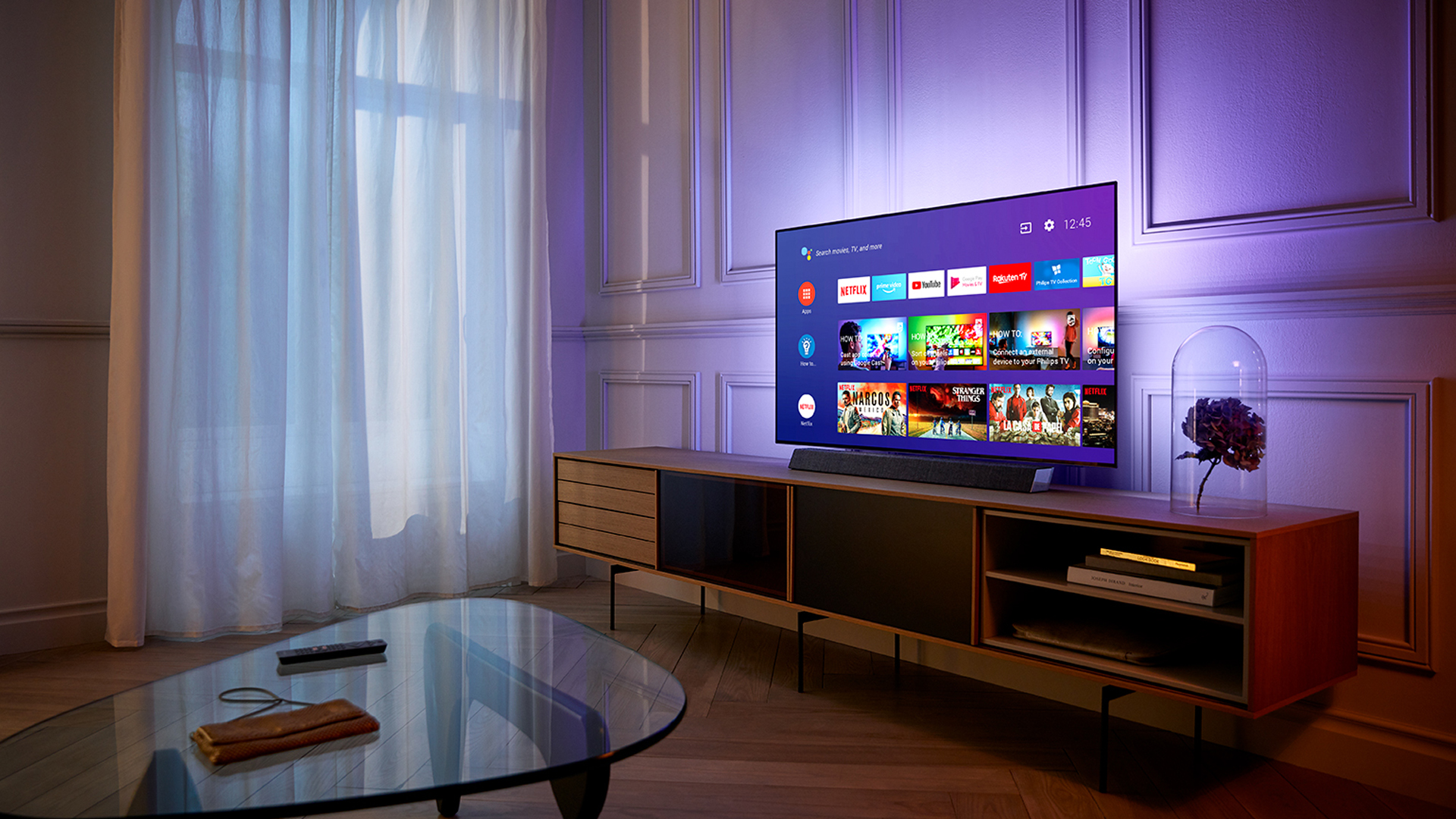TechRadar Verdict
There’s no doubt in our minds that the combination of OLED picture quality and Ambilight ambience make for a thrilling television. However, the built-in Dolby Atmos soundbar on the OLED+934 is missing a certain something...
Pros
- +
Dolby Vision and HDR10+ support
- +
Three-sided Ambilight
- +
Decent stereo sound performance
Cons
- -
Enfeebled Dolby Atmos
- -
No Freeview Play
- -
Expensive
Why you can trust TechRadar
What did we make of the new Philips OLED+934? This set, available in both 55-inch and 65-inch sizes, is certainly a premium television, with specifications worthy of its £2,999 price tag.
Like the flagship Philips OLED+984, this screen has a sound system (essentially a built-in soundbar) designed by the audio wizards at Bowers & Wilkins. While this soundbar sits below the main panel, it’s intrinsically part of the package, tethered by a captive lead. There’s no other sound system on-board, so the two are joined at the hip.
The key difference between the OLED+934 and its step-up sibling is that the former boasts a Dolby Atmos sound system, rather than a stereo speaker enclosure, and comes complete with an upwards-firing speaker array. A good number of smart TVs now offer Dolby Atmos pass-through, however the only other 4K OLED screen you can buy with an Atmos specific sound system built-in is the Panasonic GZ2000, soon to be replaced by the lookalike HZ2000.
The Philips OLED+934 isn’t perfect – as you’ll see further down in the review – but we wouldn’t rule it out either.
Design
Style is a strong point with this Philips set. With its ultra-slim bezel, the OLED+934 presents a clean, contemporary face to the world. The aforementioned soundbar is wrapped in familiar grey Kvadrat wool-blend acoustic cloth, and looks suitably attractive.
Connectivity is also on point. All four HDMI 2.0 inputs support 2160p up to 60Hz, and are ARC (Audio Return Channel) enabled. Additional connectivity includes two USBs, an optical audio output, plus Ethernet. Wireless connectivity covers dual-band Wi-Fi and Bluetooth (v4.2).
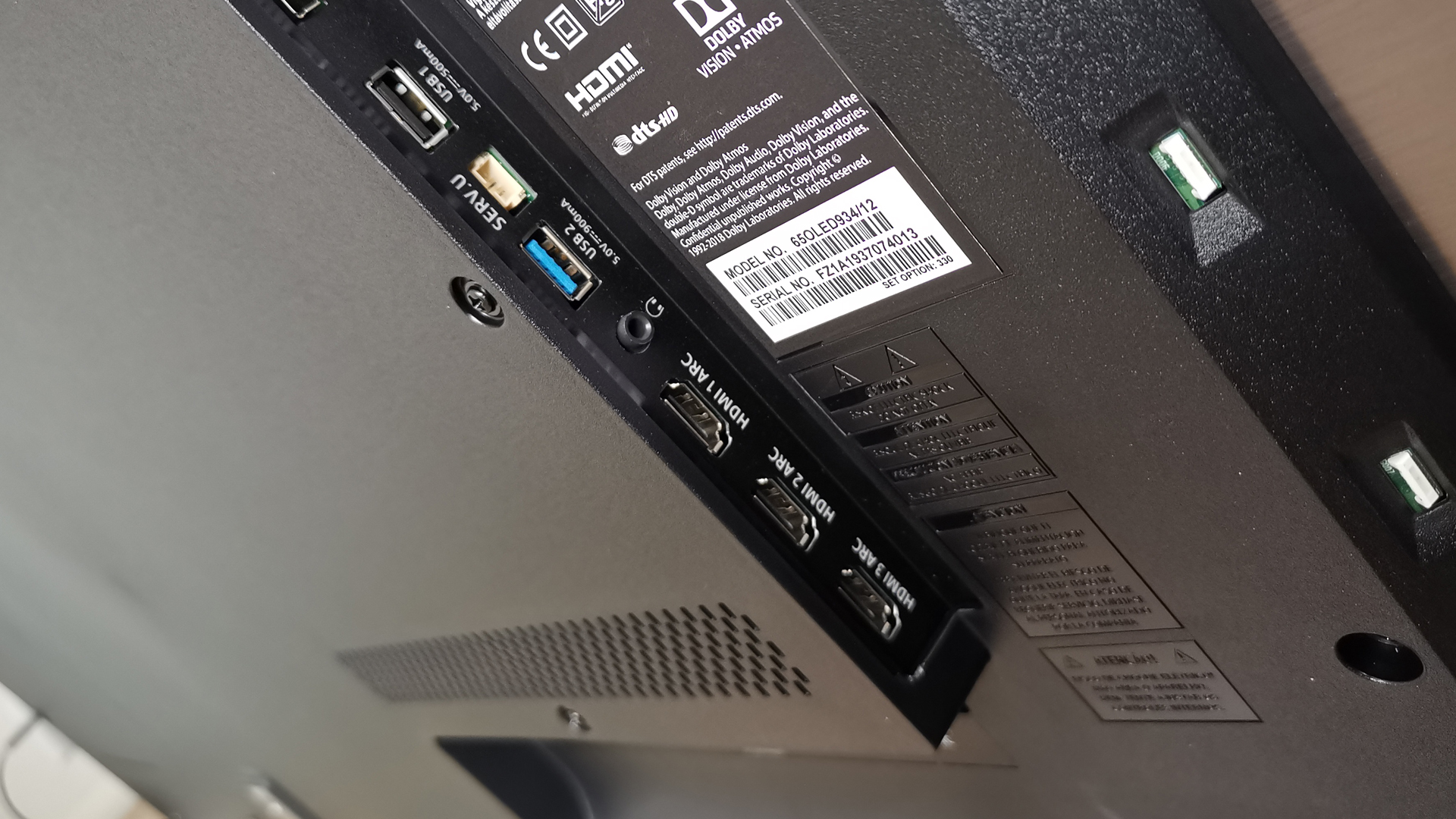
Philips Ambilight, as evidenced by the horseshoe of tiny LED bulbs on the back of the panel, is presented in a three-sided format. It works like all the other Ambilight panels in the Philips range, with the usual illumination modes: Follow Video, Follow Music, static colours and country flags. It also integrates with Philips Hue lighting systems.
While the screen sits elegantly on its central stand, there is a wall mount option, should you prefer.
Design TL;DR: With its all-in-one screen and soundbar design, the Philips OLED+934 looks slick and fashionable. The set is a good deal smaller than the step-up OLED+984 model, which also has a Bowers & Wilkins soundbar, and therefore much easier to accommodate when it comes to room placement.
Smart TV
Philips’ operating system of choice – for its OLED TVs at least – remains Android 9 Pie. It’s a fussy interface (at least when compared to Panasonic’s My Home Screen, or even Philip’s own Saphi platform), but isn’t without its charms. With support for Google Assistant and Amazon Alexa thrown in, you’ll feel suitably smart using it.
Unfortunately, the set lacks Freeview Play, which means you’ll be short-changed when it comes to mainstream catch-up services – but you do get BBC iPlayer, Netflix, Amazon Prime Video, YouTube, Google Play Movies and Music. In addition to Freeview HD, there are dual satellite tuners.
Incidentally, we’ve not yet given up on Freeview Play coming to these screens through a firmware update, should Android and certain members of the Freeview cabal come to an understanding. Fingers crossed!
Navigation is reassuringly snappy, thanks to a quad core processor. There’s 16GB of on-board flash memory, more than enough storage for apps.
As a gaming display, the OLED+934 is less impressive than we’d have hoped. We measured input lag at 33.1ms, in Game mode (1080/60), which means it falls slightly behind rival models. This isn’t a crucial performance fail by any stretch, as 30ms and lower can be considered a decent middle ground.
Multimedia file playback support is extensive, and includes MKV, AVI, MPEG, WMV, VP9 video codecs.
Smart TL;DR: Android may not be the prettiest smart TV OS available, but this iteration is feature rich and stable. A lack of mainstream catch-up players, though, means you’ll have to turn to another source – such as Pay TV box or media streaming stick – for your weekly Dr Who catch-up.
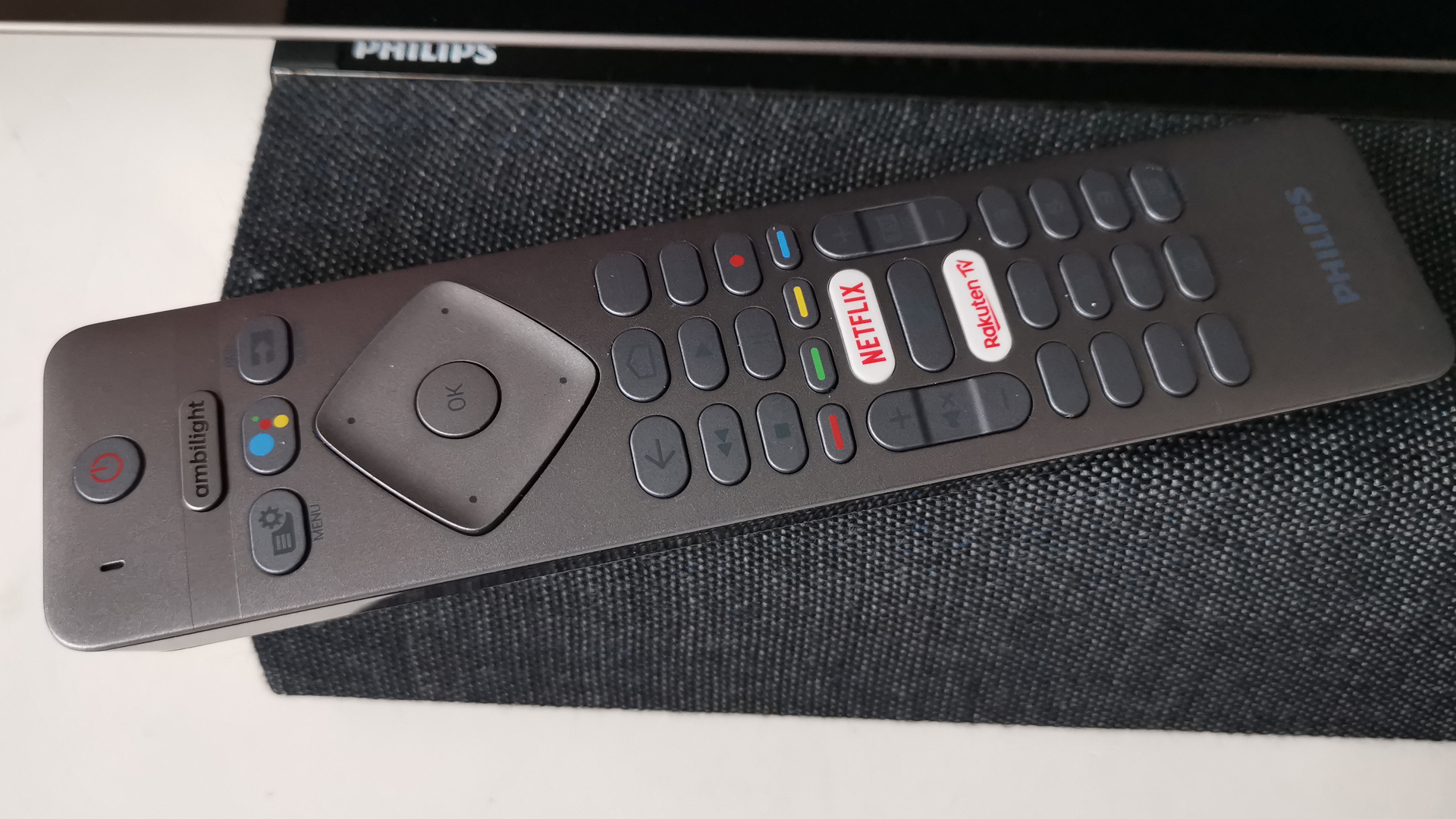
HD/SDR Performance
Philips certainly knows how to put the wow factor into its screens. When it comes to OLED panel and image processing prowess, the 934 doesn’t skimp. It uses the brand’s third generation P5 picture processing engine, which features an armoury of refinements and algorithms able to optimise both HD and 4K sources.
Regarding the former, Philips has made an art of elevating HD SDR sources to something akin to genuine HDR. A slew of processing modes offer advanced noise reduction, greater delineation of detail, colour accuracy and extreme contrast.
This really helps when it comes to displaying regular HD – so much so we suspect many viewers won’t discern much difference between SDR and native HDR.
Philips P5 image processor is able to boost overall image brightness, without sacrificing contrast or bite.
HD/SDR TL;DR: Philips P5 image processor is one of the best out there, HD content benefits from superb black level performance and excellent upscaling so you can be sure HD TV and regular Blu-ray always looks its best.
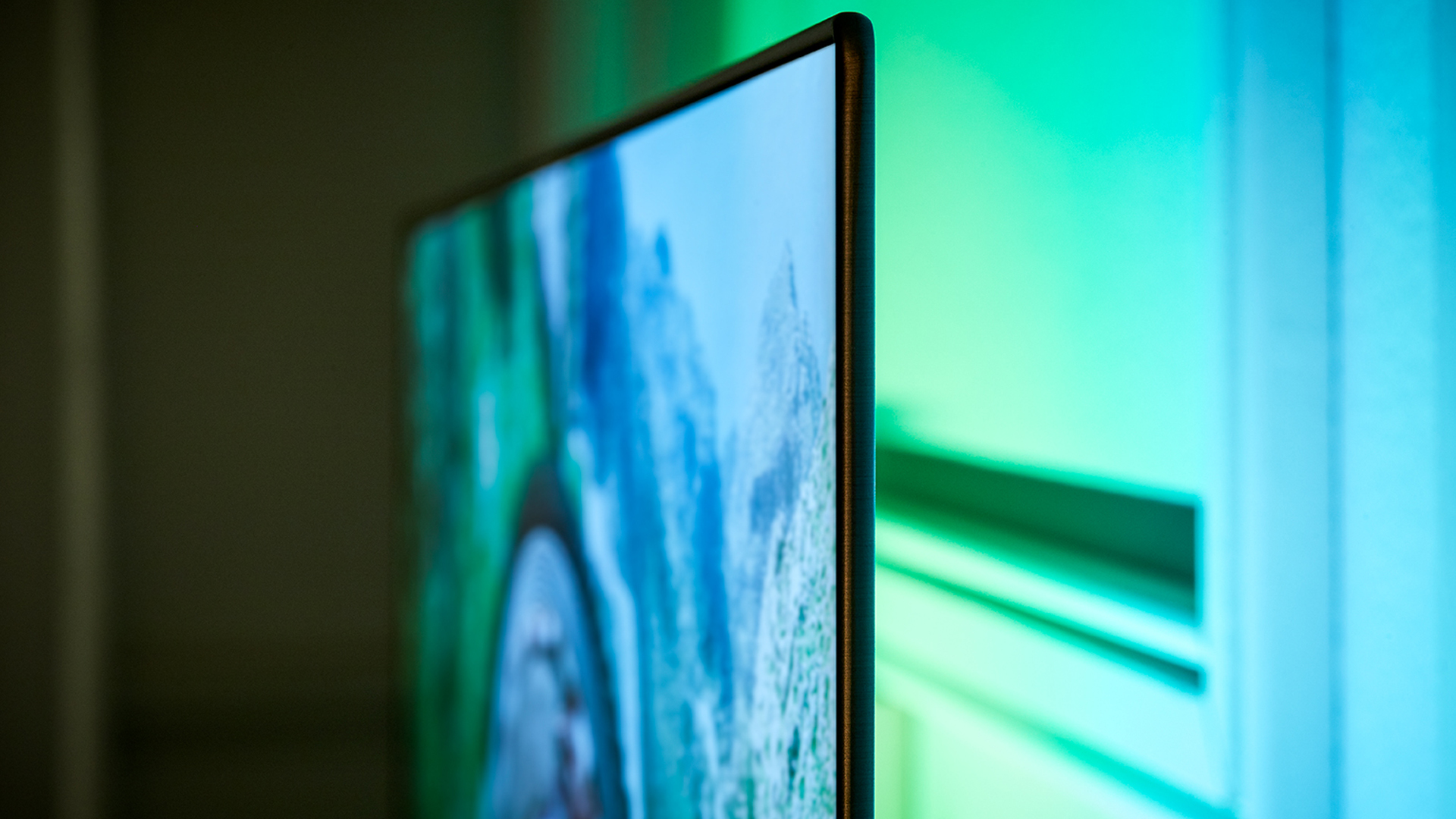
4K/HDR Performance
Straight from the box, the OLED+934 is an unabashed 4K crowd-pleaser. When it comes to pixel prowess, there’s nothing that separates this model from its OLED+984 stablemate. This, in case you’re wondering, is a good thing – as Philips' approach to image processing in both sets is to celebrate vibrancy and impact.
To start, HDR support is universal. In addition to HDR10 and HDR10+, there’s HLG and Dolby Vision on-board too.
Pronounced contrast adds depth to its images, and specular highlights really shine. Colour vibrancy is exceptional too, with a wide colour gamut panel that claims to cover 99% of the DCI/P3 specification.
In HDR Natural picture mode, we measured peak brightness at around 750 nits on a standard 10% brightness window. Reducing this window to 5 per cent allows for even greater dynamics, with the set delivering an impressive 980 nits. This more accurately reflects how HDR is more commonly used: sparingly for greater impact.
A word of caution: should you feel obligated to watch using the HDR Movie preset, the set’s ability to deliver peak highlights is limited to around 640 nits, which isn't very bright. We recommend sticking with Natural – if not HDR Vivid.
4K/HDR TL;DR: Inevitably, the set is at its best with native 4K. Universal HDR support is very welcome, while dynamics and detail are excellent. Dolby Vision HDR can look a little dark here, but a tweaked Bright mode makes images really zing.

Sound
The built-in soundbar is a big part of the OLED+934’s identity, and also means it’s unlikely you’ll be buying this TV with an external sound system in mind. This is meant to be an all-in-one AV solution.
The fabric-wrapped speaker enclosure hides four 30mm mid-range drivers, two 19mm titanium tweeters and a centrally mounted, 80mm subwoofer. Twin 50mm upward-firing Dolby Atmos elevation units deliver height information, while total audio output is rated at a cumulative (and respectable) 50W in a 2.1.2 Dolby Atmos sound system.
First, the good stuff. This sound system is genuinely stereophonic: the enclosure employs a lot of clever Bowers & Wilkins structural techniques, with braced internal rib sections to combat unwanted resonance, and drivers housed in a rigid, acoustically optimised enclosure made of glass-fibre-reinforced ABS.
In addition to Dolby Atmos enabled apps, the sound system decodes Atmos delivered by Blu-ray or via Dolby Digital Plus, from a premium pay TV service. Both Sky Q and BT TV support the 3D audio format for sports, and in Sky’s case, certain TV shows and movies.
To get a real sense of this soundbar’s scale, take a listen to Britannia (Dolby Atmos on Sky Atlantic). The mix is convincingly immersive, and the opening theme, Donovan’s Hurdy Gurdy Man, really shows off the TV’s ability to cast audio wide and high.
The set is also above average when it comes to dialogue articulation, which is centre-locked and crisp. Daddy’s Home 2 (Sky Cinema, Dolby Atmos), demonstrates just how effortlessly the Philips separates dialogue from an incidental pop music backing track.
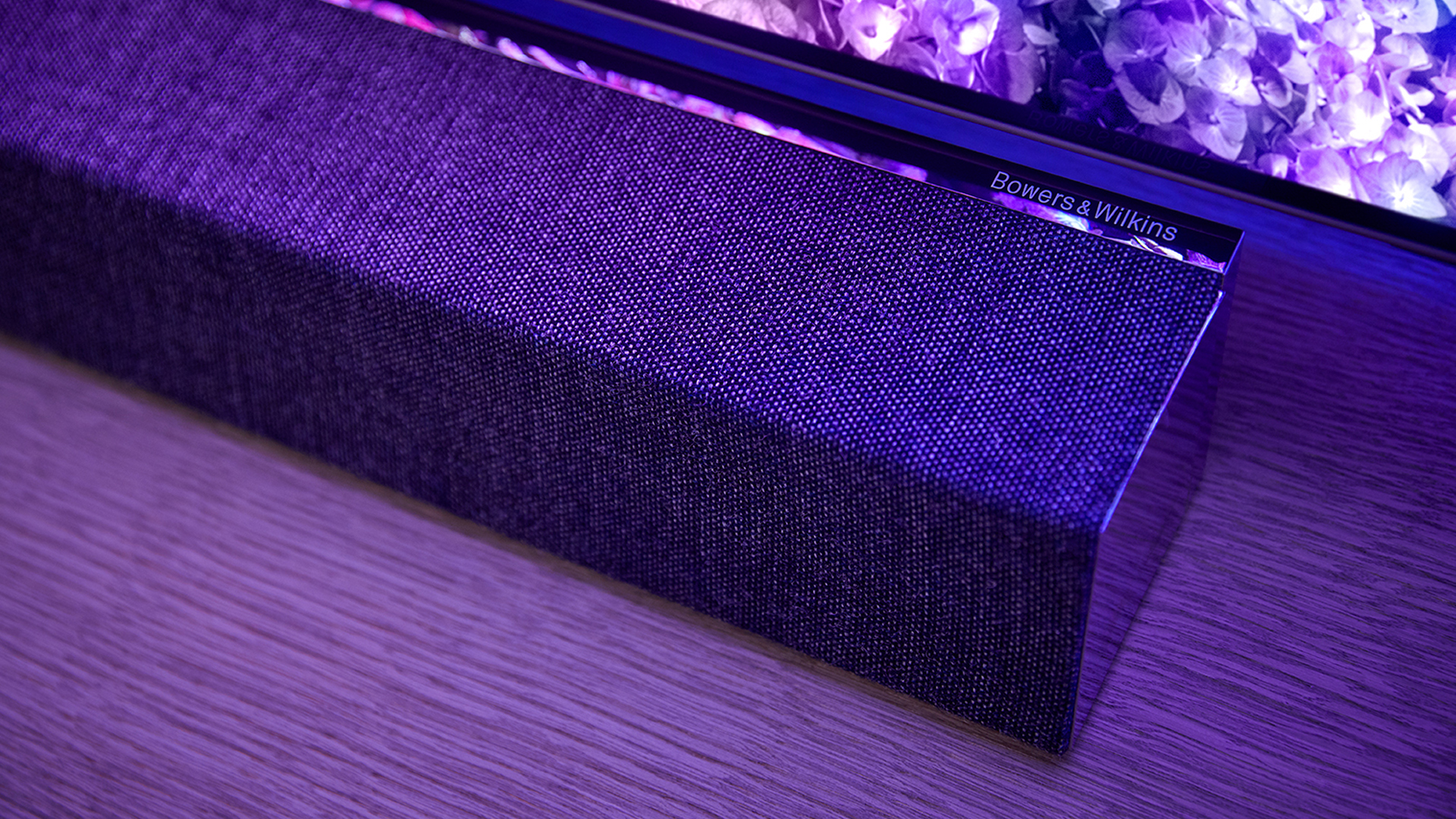
Unfortunately, we aren’t as enthusiastic as the bass. For reasons best known to Philips, Bowers and Dolby, the surround processor in this screen completely ignores the LFE (Low Frequency Effects) channel in a multichannel mix.
Clearly there are limits to what can be achieved with LFE in a TV soundbar, but to simply exorcise an entire sound channel comes with consequences, replacing dramatic movie LFE effects with an all-too-obvious silence. That deep rumble of thunder? It’s nowhere to be heard...
What this set should do is subsume the LFE within the left/right channels. It’s a misnomer to think that the LFE in an Atmos or 5.1 mix only handles ultrasonics. The sound designer can place anything, from low to mid-bass into the point one, and the sound system of this Philips is more than capable of handling anything down to 50Hz.
The outcome of this is that the OLED+934 simply isn’t up to scratch as a home cinema system, being unable to offer LFE sound effects in its Dolby mixes.
The good news is that Philips tells us that it’s looking into the feasibility of a firmware update to assist with this, and that future Philips screens with a dedicated Atmos sound system will correctly sum the LFE into the main stereo pair, so that there are no awkward silences.
HD SDR TL;DR: The Bowers & Wilkins sound system here is a definite step up from typical TV audio systems. The soundstage is wide and there’s a decent (mid) bass performance. But the missing LFE channel makes Dolby Atmos-encoded movies sound all kinds of wrong...
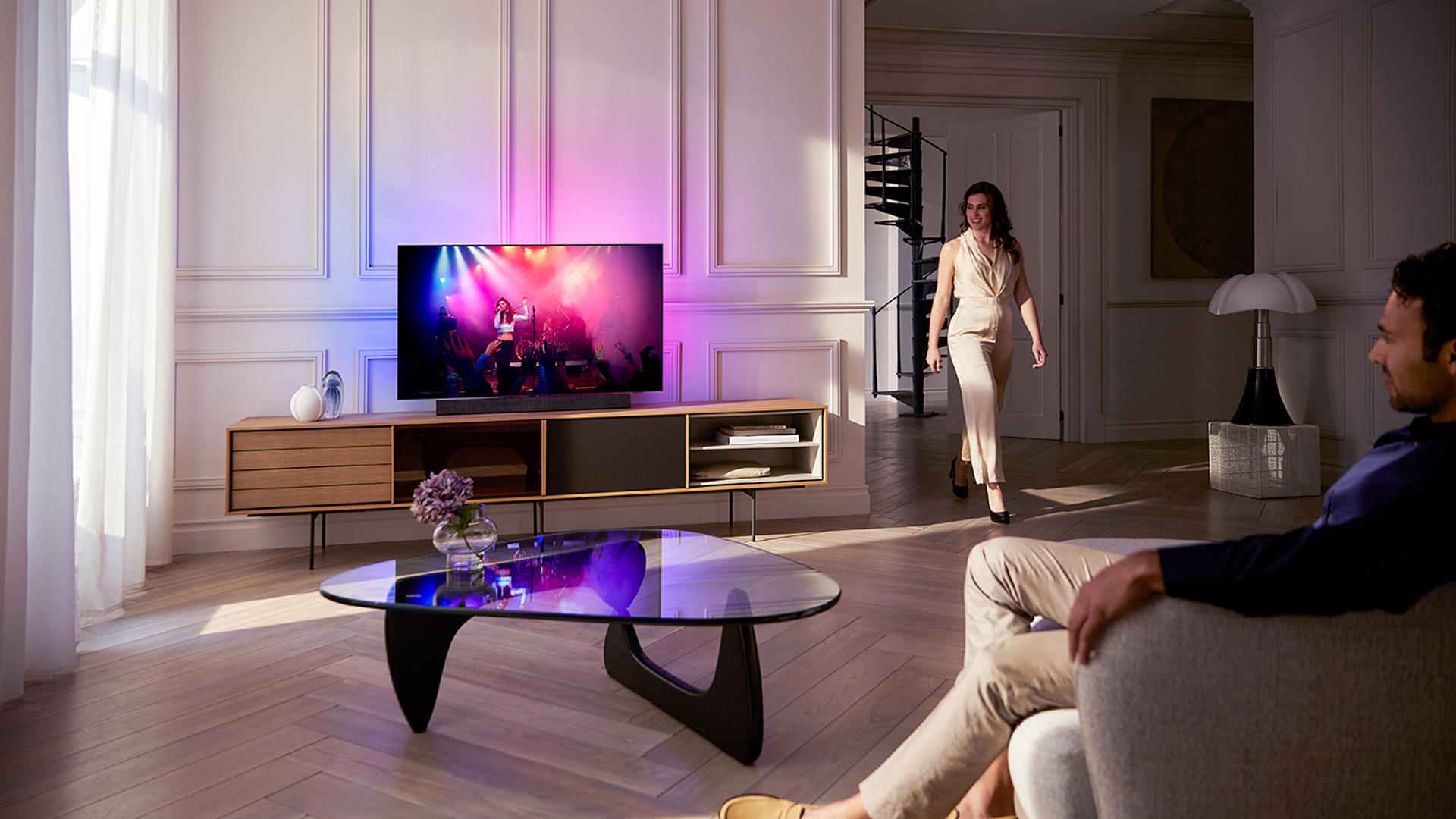
Verdict
The OLED+934 is an ambitious home cinema OLED package that aims high and almost pulls it off. The picture quality is brilliant, thanks to support for Dolby Vision and HDR10+ plus vibrant HD upscaling, but the audio is a more contentious issue.
Sure, it’ll outperform many integrated rival sound systems, but avid home theatre fans will be disappointed: ignoring the point one LFE bass channel in a multichannel mix simply doesn’t make for good audio.
- Philips TV 2020: every new set coming this year
Steve has been writing about AV and home cinema since the dawn of time, or more accurately, since the glory days of VHS and Betamax. He has strong opinions on the latest TV technology, Hi-Fi and Blu-ray/media players, and likes nothing better than to crank up his ludicrously powerful home theatre system to binge-watch TV shows.
